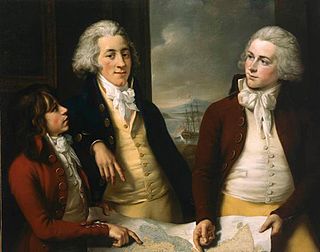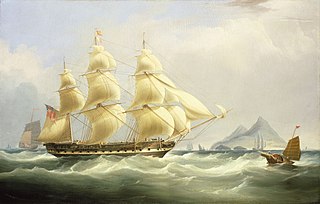Albion was a sailing ship of two decks and three masts, built at Bristol, England, and launched in 1813. She made three voyages transporting convicts to Van Diemen's Land and New South Wales. She also traded with Jamaica, India, and Quebec. For two of the voyages to India she was an "extra" ship to the British East India Company (EIC).
Royal Captain was a three-decked East Indiaman, launched in 1760, that made four voyages for the British East India Company between 1761 and 1771. She was sold 1771 for breaking up.
Lapwing was one of four fast-sailing packet ships that Thomas Bronsdon of Deptford built for the British East India Company (EIC). She was launched in 1743 and made five trips for the company before the EIC sold her in 1751.
Lapwing was a packet ship that made two round-trips to India for the British East India Company (EAC). Currently, both her origin and her fate are obscure, though it is possible that she was launched at Hull in 1745 and was last listed in 1789.
Malabar was the Nieuwland, launched in 1794 for the Dutch East India Company. The British seized her in 1795 and new owners renamed her Malabar. She made two complete voyages under charter to the British East India Company before she burnt at Madras in 1801 in an accident.
Caledonian was launched on the Thames River in 1797. Between 1798 and 1803 she made two voyages to China and India as an "extra ship", i.e., under charter to the British East India Company (EIC). She sustained severe damage on the first. She burnt accidentally in 1804.
Queen was launched at Quebec in 1795. She made three voyages for the British East India Company (EIC) and then became a West Indiaman, trading between London and West Indies. She was last listed in 1813.
Airly Castle, was built by William Barnard at Deptford and launched in 1787. She made eight voyages as an East Indiaman for the British East India Company (EIC) between 1788 and 1808. In 1795 she participated in the capture of seven Dutch East Indiamen near St Helena. After her eight voyages she may have served briefly as a general transport before she was sold for breaking up in 1810. She was not broken up but instead served as a transport for several years.
Monarch was built at Quebec in 1800. She sailed to England, being captured and recaptured shortly before arriving. In England, under new ownership, she proceeded to make five voyages for the British East India Company (EIC) as an "extra ship", that is, under voyage charter. In 1813 she became a transport, and then in 1818 or so a regular merchantman. She was broken up in 1820.
Contractor was launched in 1779 as an East Indiaman. She made seven voyages for the British East India Company (EIC). She made one voyage as a transport for a military expedition before her owners sold her in 1800 for use as a transport.
Dublin was launched in 1784 as an East Indiaman. She made six voyages for the British East India Company (EIC), to India and China. On her last voyage for the EIC she recaptured a country ship. Her owners sold Dublin in 1800 and she became a West Indiaman, but apparently was lost on her first voyage.

Rose was launched in 1786 as an East Indiaman. She made six voyages between 1787 and 1800 for the British East India Company (EIC). She also participated as a transport for a military expedition to the West Indies. She then made one more voyage for the EIC, bringing rice back to England from Bengal. Next she sailed as a general trader, but also made one voyage seal hunting. She was last listed in 1820.
Glory was an East Indiaman launched in 1802. She made two complete voyages as an "extra ship" for the British East India Company (EIC) before she disappeared in November 1808 while homeward bound from her third voyage. On her second voyage she participated in the British expedition to capture the Cape of Good Hope.
Calcutta was launched in 1798 as an East Indiaman. She made four voyages for the British East India Company (EIC), and disappeared while homeward bound from Bengal on her fifth voyage.
Berrington was launched in 1783. She made six voyages as an East Indiaman for the British East India Company (EIC). She then became a West Indiaman before again making a voyage under the auspices of the EIC to bring rice from Bengal to England for the British government. She returned to Indian waters and was last listed in 1807.
Minerva was launched as an East Indiaman in 1786. She made seven voyages for the British East India Company (EIC), and one carrying rice from Bengal for the British government. She is last listed in 1805 but with stale data from 1802.
Sovereign was launched at Rotherhithe in 1800 as a West Indiaman. The British East India Company (EIC) then took her up as an "extra" ship on several contracts; in all she made seven voyages as an East Indiaman for the EIC. After she left the EIC's service in 1817 she continued to trade with India, but under a license from the EIC. She was broken up in 1822.
William Pitt was launched on the River Thames in 1785 as an East Indiaman. She made six voyages for the British East India Company (EIC). During her fourth she served as an ad hoc warship in a naval campaign during which she saw action. Thereafter she served as a transport, including one voyage in 1801-1802 transporting rice from Bengal to Britain. She was sold for breaking up in 1809.
Glatton was launched as an East Indiaman. She made four voyages for the British East India Company (EIC) before her owners sold her in 1772. Her new owner, James Mather, renamed her Lord Howe and first deployed her to bring timber from North America to England. Mather then hired her out as a transport. She was last listed in 1782 and was probably the "ordinance storeship Lord Howe" that foundered in that year.

Asia was launched in 1811 on the River Thames as an East Indiaman. She made 10 voyages for the British East India Company (EIC). She then continued to sail to India and China after the EIC gave up its trading activities in 1834. She was condemned and hulked in 1840.

